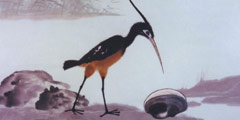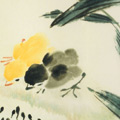At the origin of all the Oriental cultures, China is considered the first country in the Orient to have realised an animated lenght feature film: Princess Iron Fan (1941) by the brothers Wan, then founders of the most important school for animation of the country, the Shangai Animation Film Studio.The Future Film Festival would give a tribute to the Chinese school of animation because his tradition whose encloses in his own a long evolution from the shade’s theatre to the puppet’s theatre.
The tribute is realised thanks to the care of Laura Zanardi and Luca Della Casa.
Here the calendar of the Future Film Festival 2007:
Il programma
The Cicada and the Praying mantis (Tang Ian bu chan)
by Hu Jinqing (China, 1988) 5’
An ancient proverb said: “The praying mantis chases the cicada without knowing that the bird is peeping it”. A Liu Xiang’s writ who goes back to 2000 years, at the time of Emperor Han. It’s necessary to distrust! Its’ always possible to be prey of someone stronger.
The Scarecrow (Chao ren)
by Hu Jinqing (China, 1985) 10′
It’s the arrangement of the very ancient book Comic Tales dated on times of the Warriors Kingdom (-445, -221 b.C.) and the topics are the discernment of the true-false, the craftiness and, above all concerning to the art of war, the wisdom to stay in a place to decide the action in the right moment, by surprise, to win.
The monkeys who want the moon (Honzi lao yue)
by Zhou Keqin (China, 1981) 81′
It is an arrangement of a very ancient popular tale, inspired by the Confucio’s precepts which prove that the appearance lies.
Feeling from Mountain and Water (Shan shui qing)
by Te Wei (China, 1988) 19′
The movie used the rare technique in the world, tweaked by Te Wei since 1960 with the film Where is Mama?: the animation with India inked drawings, faded and waterco loured whose secrets he only holds. The animation is so perfect and magic that everybody can forget about the difficulties which involves.
The oyster and the heron (Yubang xiangsheng)
by Hu Jinqing (China, 1983) 10′
This film is, like the others, an arrangement inspired by a very ancient book Comic tales about tactics of war: when two people are quarrelling the third one usually gets the prize.
Where is Mama? (Xiao ketou zhao mama)
by Te Wei (China, 1960) 15′
It is an arrangement of an ancient and popular tale, which is taken as a pretense for Te Wei to animate the Qi Baishi’s painting in a very extraordinary way. A tale for everyone which let kids and growns-up reassure themselves similar to a baby in search of his mother among the crowd or in a desert country.
The three Monks (Sange heshang)
by Ah Da (China, 1980) 19′
A tale full, of gags and visual expedients, with a great moral sense about selfishness and human hypocrisy sets in an unusual and unique world.
Princess Iron Fan (Tieshan gongzhu)
by Wan Laiming and Wan Guchan (China, 1941) 70′
With the collaboration of Fondazione Prada and La Biennale di Venezia
Princess of Iron Fan is the first animated lenght feature film realised in Asia. It tells, thanks to animated drawings, a part of the Journey to the West, the mithological chinese tale whose characters are the monk Tripitaka and the Scimmiotto, who are searching the magic iron fan able to move winds and to win fire devils.
Jiaoao de jiangiun
by Te Wei (China, 1956) 30′
It is a refined satire about power and militarism which says how also high soicla charges should remain modest to behave with other people.
Little carps at the dragon’s door (Xiao liyu tiao long men)
by He Yumen (China, 1958)
This short, inspired by a populare tale, is an allegory about the difficulties in our life. Through the adventures of some little carps trying to up the river, we can read the wisdom of the Chinese fairy tale. By contrast, the striking pictures remind to bright paintings of imperial palaces.





